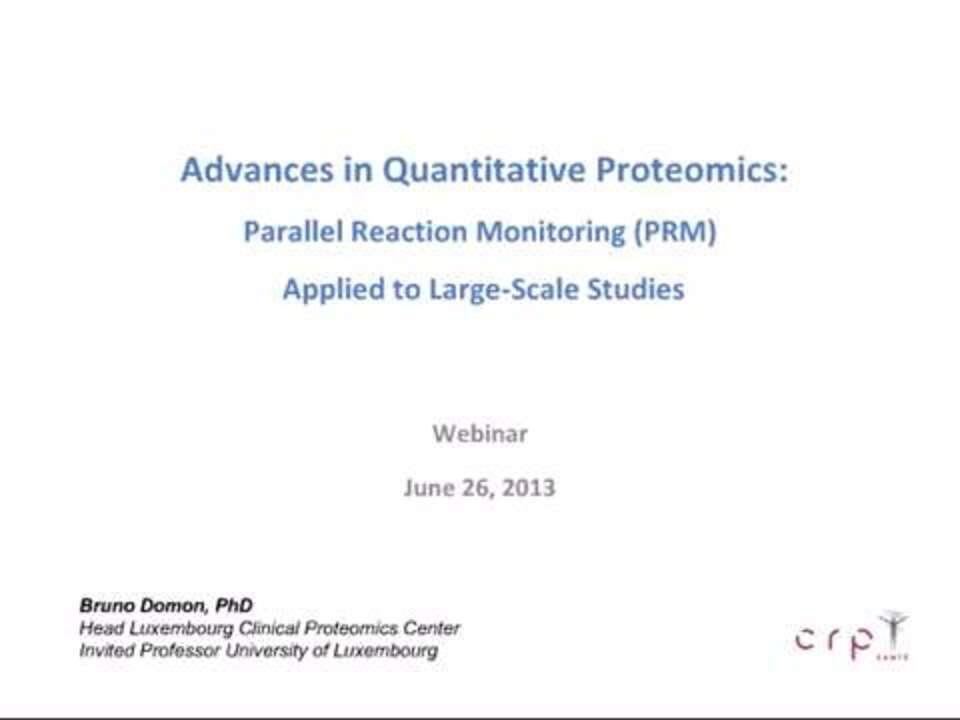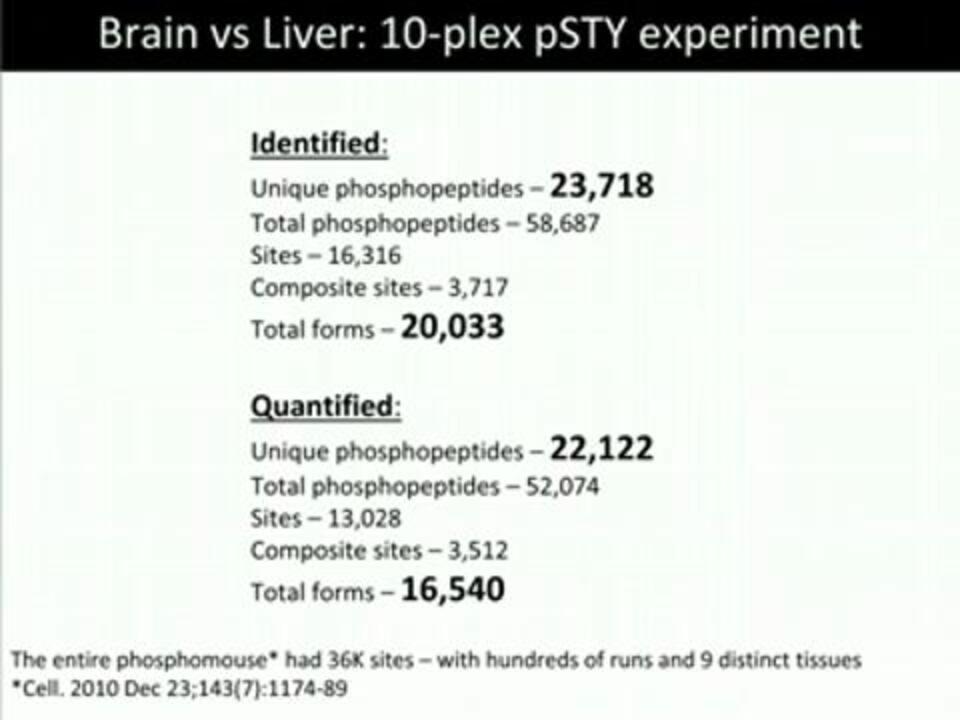Search Thermo Fisher Scientific
Proteomics Protein Quantitation Information

Quantitative analysis of biomarkers
From biomarker discovery by identification of proteins with statistically significant changes in abundance to verification and validation of putative biomarkers, protein research frequently requires quantitative analysis of proteins. A wide array of LC-MS techniques is available for quantitative analysis of proteins. Some can be performed on triple quadrupole mass spectrometers. Others require the high mass resolution and mass accuracy of Thermo Scientific Orbitrap™ technology.
Selected-reaction monitoring (SRM) on triple quadrupole mass spectrometers is the traditional “gold standard” for targeted protein quantification. It involves the analysis and quantitation of target peptide ions characteristic of the targeted proteins. SRM quantitation is extremely sensitive, reliable, and suitable for analyzing large numbers of samples. The biggest limitation of SRM quantitation is the need to determine in advance the MS/MS product ion(s) that can be use for confirming the identity of each target ion. This makes method development challenging. Thermo Scientific triple quadrupole LC-MS/MS systems are ideal for SRM quantitation of protein samples, providing outstanding sensitivity and reliability. Thermo Scientific Pinpoint™ software is specifically designed to set up SRM assays, process the resulting data, and use the results to further refine the assay.
More information about:
Parallel-reaction monitoring (PRM) provides high selectivity, high sensitivity, and high-throughput quantification with confident targeted peptide confirmation. PRM is most suitable for quantifying tens to hundreds of targeted proteins in complex matrices.
PRM methodology isolates target precursor ions, fragments the precursors, and then detects all resulting product ions in the Orbitrap mass analyzer. Quantification is carried out using selected fragment (product) ions post data acquisition. PRM reduces assay development time since no target transitions (product ions) need to be preselected. It eliminates most interferences, providing more accuracy and attomole-level limits of detection and quantification. It also enables the confident confirmation of the peptide identity with spectral library matching. The Thermo Scientific Q Exactive™ hybrid quadrupole-Orbitrap instruments are ideal for PRM analyses.
More information about:
Selected-ion monitoring (SIM) provides the simplest method set up and the most selective and sensitive quantification. It also provides higher sensitivity for quantification of labile peptides which do not fragment efficiently. SIM is most suitable for quantifying tens of proteins in samples of medium complexity.
SIM methodology isolates a selected peptide ion characteristic of the targeted protein. Only the selected target ion is transferred to the Orbitrap mass analyzer for detection. There is no fragmentation. Confirmation of the targeted peptide is accomplished using accurate-mass measurements in combination with elution-time information. Q Exactive hybrid quadrupole-Orbitrap mass spectrometers are the instruments of choice for SIM analyses.
More information about:
Data-Independent Acquisition
Data-independent acquisition (DIA) provides a high throughput method for comprehensive quantification with qualitative confirmation. It is most suitable for quantifying large numbers of mid- to high-abundance proteins in samples of simple to medium complexity.
Unlike SRM, PRM, or SIM experiments, DIA does not require advance selection of target peptides. Instead, a precursor mass range is selected, usually one that covers the masses of most enzymatic peptides. That range is then divided into a series of relatively wide isolation windows. MS/MS data is acquired from all detected precursor ions in the first isolation window. That is repeated for each consecutive, adjacent isolation window until the entire precursor mass range is covered. MS/MS spectral libraries are used to identify peptides of interest from the acquired data.
DIA significantly increases coverage and reproducibility by acquiring MS/MS data from all detected precursor ions. This also makes possible retrospective data analysis. Because no prior knowledge of expected precursors is required, DIA method development is very simple. Due to the wide isolation windows used in DIA, MS/MS spectra of interfering background ions may be acquired along with the spectra from peptides of interest. Thus, the dynamic range, accuracy, and precision of targeted quantification by DIA may be limited in complex samples. DIA experiments do not provide the same sensitivities and low quantitative limits as PRM and SIM.
Multiplexed DIA (msxDIA) is a variation of the DIA technique. It can reduce interference from background ions and improve selectivity while retaining the comprehensive coverage of DIA.
DIA and msxDIA techniques have been designed to take advantage of the unique capabilities of Q Exactive hybrid quadrupole-Orbitrap mass spectrometers.
More information about:
Sample Preparation and Labeling Technologies
A range of protein sample preparation techniques are available that can improve protein quantitation by helping you get more, or more accurate, information from your samples, and increase sample throughput. They include:
- Metabolic (in vivo) labeling with stable isotopes
- Isotopic tags
- Isobaric mass tags
- Spiked heavy peptides
Thermo Fisher Scientific offers a complete range of products to enhance your quantitative proteomics analyses.
More information about protein sample preparation solutions
Dr. Bruno Domon of the Luxembourg Clinical Proteomics Center, CRP Sante, discusses the challenges of quantitative proteomics, particularly in the context of clinical samples. He presents a parallel-reaction monitoring (PRM) workflow for large-scale quantitative proteomics research and also discusses targeted versus untargeted methods.
Pushing the Boundaries of Protein ID, Characterization & Quantitation
- Advancing the sensitivity of selected reaction monitoring-based targeted quantitative proteomics
- Automated selected reaction monitoring data analysis workflow for large-scale targeted proteomic studies
- Mass spectrometry-based targeted quantitative proteomics: achieving sensitive and reproducible detection of proteins
- Multiplexed MS/MS for improved data-independent acquisition
- Platform for establishing interlaboratory reproducibility of selected reaction monitoring-based mass spectrometry peptide assays
- Quantitative mass spectrometric multiple reaction monitoring assays for major plasma proteins
- Selected reaction monitoring-based proteomics: workflows, potential, pitfalls and future directions
- Targeted peptide measurements in biology and medicine: best practices for mass spectrometry-based assay development using a fit-for-purpose approach
- Targeted quantitation of proteins by mass spectrometry
Clinical & Translational Resource Library
Access a targeted collection of scientific application notes, case studies, videos, webinars, and white papers for clinical and translational research.


